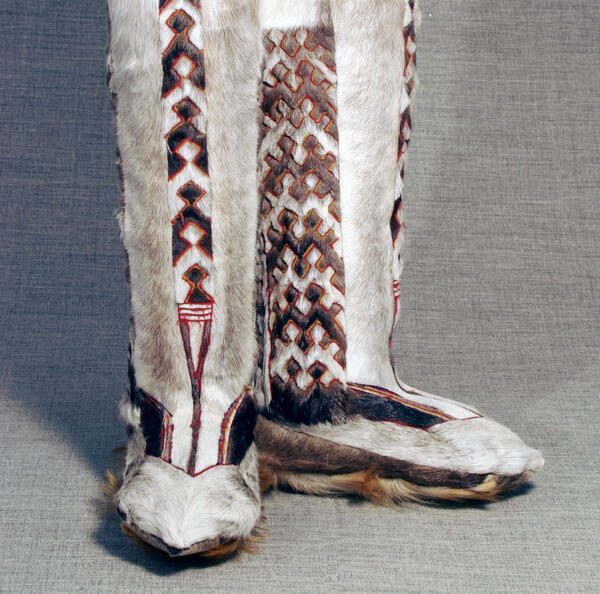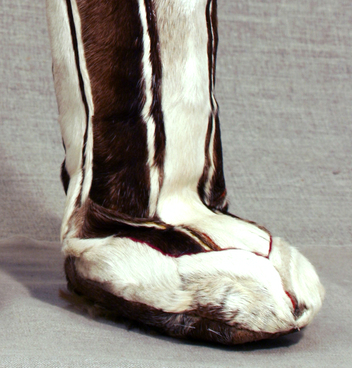KisY is a traditional winter fur footwear of the Forest NEnets people, fitting severe Northern climate, household activities and Tundra inhabitants’ way of life perfectly. They keep warmth even when it is colder that –40°C. This footwear consists of stockings sewn with fur inside and the outer part made of kamus (reindeer legs skin) with fur out. Female version differs from a male one with tailoring, the front strip of kamus is narrower and ends before the toe cap. Unlike male kisy boots, female ones are a bit shorter, they are not tied up under the knee but only to a belt.
Kisy boot are hand sewn and decorated by dark or light fur, edging made of colorful cloth, traditional ornaments. As the Nenets women’s clothing is much longer than of men, fur ornaments are placed significantly lower to be seen. Besides the pattern on the toe cap, fur ornament of two-colored kamus and cloth is also applied on lateral and back sides. Complicated ornamental motifs serve not only as a decoration, but also as an important symbol. It is a sort of alphabet the Nenets use to communicate with each other.
According to a legend from ‘The House of Winds’ book by Polina Turutina, the Nenets folklore collector, decoration of female footwear is a set of rules a woman must stick to during her whole life. ‘The ornament of your kisy boots isn’t just a pattern. The triangle of kisys is your chum. The crossing strips are taboos. The upper ring is the sky above your head. Strips spread in different directions may mean rays of the Sun above a chum. Ornament around kisy means you are not alone, there are also other people living around you. This is the way to your chum. You’ll bring your future son’s bride with it one day. You’ll take the same road to send your daughter to another family’, the author writes.
The kisy boots displayed in the exposition of the museum are provided by the Forest Nenets Galina Sergeeva, a Gubkinsky town resident.
Kisy boot are hand sewn and decorated by dark or light fur, edging made of colorful cloth, traditional ornaments. As the Nenets women’s clothing is much longer than of men, fur ornaments are placed significantly lower to be seen. Besides the pattern on the toe cap, fur ornament of two-colored kamus and cloth is also applied on lateral and back sides. Complicated ornamental motifs serve not only as a decoration, but also as an important symbol. It is a sort of alphabet the Nenets use to communicate with each other.
According to a legend from ‘The House of Winds’ book by Polina Turutina, the Nenets folklore collector, decoration of female footwear is a set of rules a woman must stick to during her whole life. ‘The ornament of your kisy boots isn’t just a pattern. The triangle of kisys is your chum. The crossing strips are taboos. The upper ring is the sky above your head. Strips spread in different directions may mean rays of the Sun above a chum. Ornament around kisy means you are not alone, there are also other people living around you. This is the way to your chum. You’ll bring your future son’s bride with it one day. You’ll take the same road to send your daughter to another family’, the author writes.
The kisy boots displayed in the exposition of the museum are provided by the Forest Nenets Galina Sergeeva, a Gubkinsky town resident.



